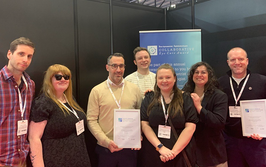An ARIStocratic Endeavor
Why do up to a fifth of patients with early-stage AMD progress to late-stage disease within five years – while the rest do not?

Around 10–20 percent of people who are diagnosed with early-stage age-related macular degeneration (AMD) go on to develop late-stage disease within five years, which throws up some important questions: Who are the people in this 20 percent? Can we predict who is (or is not) likely to be in this 20 percent? And, perhaps most importantly, why do these patients progress so quickly?
It’s against this background that the US National Eye Institute (NEI) is running a new AMD natural history study (1) called ARIS: the AMD Ryan Initiative Study, in memory of the late Stephen J. Ryan, an expert in retinal disease and former President of the Doheny Eye Institute. The study will recruit up to 500 participants aged 55 years and older and follow them over a five-year period with the primary outcome measure of “Enhancing the understanding of the natural history of AMD and reticular pseudodrusen (RPD).”
Participants are required to have BCVA of 20/25 or better at enrolment and submit to yearly assessment. Those with a history of peripheral laser and cryotherapy for peripheral tears or cataract surgery >3 months beforehand were not excluded from the trial, although people with glaucoma/ ocular hypertension, any evidence of choroidal neovascularization or geographic atrophy were excluded from trial entry. Any ocular disease (other than AMD), prior ocular surgery, or receipt of chronic therapy that might confound the assessment of the retina are also exclusion criteria.
Those under assessment will be split into three cohorts:
- Early AMD: medium drusen An ARIStocratic Endeavor Why do up to a fifth of patients with early-stage AMD progress to late-stage disease within five years – while the rest do not? www.theophthalmologist.com Upf ront 9 (>63 μm and ≤125 μm) OU, n=200;
- RPD: ≥1 eye with RPD with ≤1 large drusen (>125 μm in either eye), n=200;
- Age-matched controls: No drusen >63 μm, no RPD or pigmentary changes OU, n=100.
Despite being funded by the US NEI, sites in the UK, Australia, Germany, and Italy (as well as a number in the US) will participate. The study investigators will employ the latest imaging and functional vision assessment instruments to assess the retinae of the study participants, including SD-OCT; dark-adapted fundus perimetry and dark-adaption testing, as well as dilated pupil eye exams, fundus photography, visual acuity assessments, medical histories and physical exams and questions about their vision and general health. The study may also include genetic analysis to determine if any correlations exist between gene sequences and AMD progression.
In return for running the study, the NEI will receive a comprehensive dataset from patients with a multifactorial disease and differing genetic and environmental risk factors – any of which may tip them into the late-stage bracket more rapidly than others. NEI Deputy Director Emily Chew explains the aim: “The findings will contribute to our understanding of the underlying biology driving the transition from early to late-stage disease so that therapies can be developed to halt its progression. Treatments that halt the disease at its early stage would have an enormous public health impact.”
- Clinicaltrials.gov, “AMD Ryan Initiative Study (ARIS)”, Available at: https:// clinicaltrials.gov/show/NCT03092492. Last accessed March 05, 2018.
I spent seven years as a medical writer, writing primary and review manuscripts, congress presentations and marketing materials for numerous – and mostly German – pharmaceutical companies. Prior to my adventures in medical communications, I was a Wellcome Trust PhD student at the University of Edinburgh.













